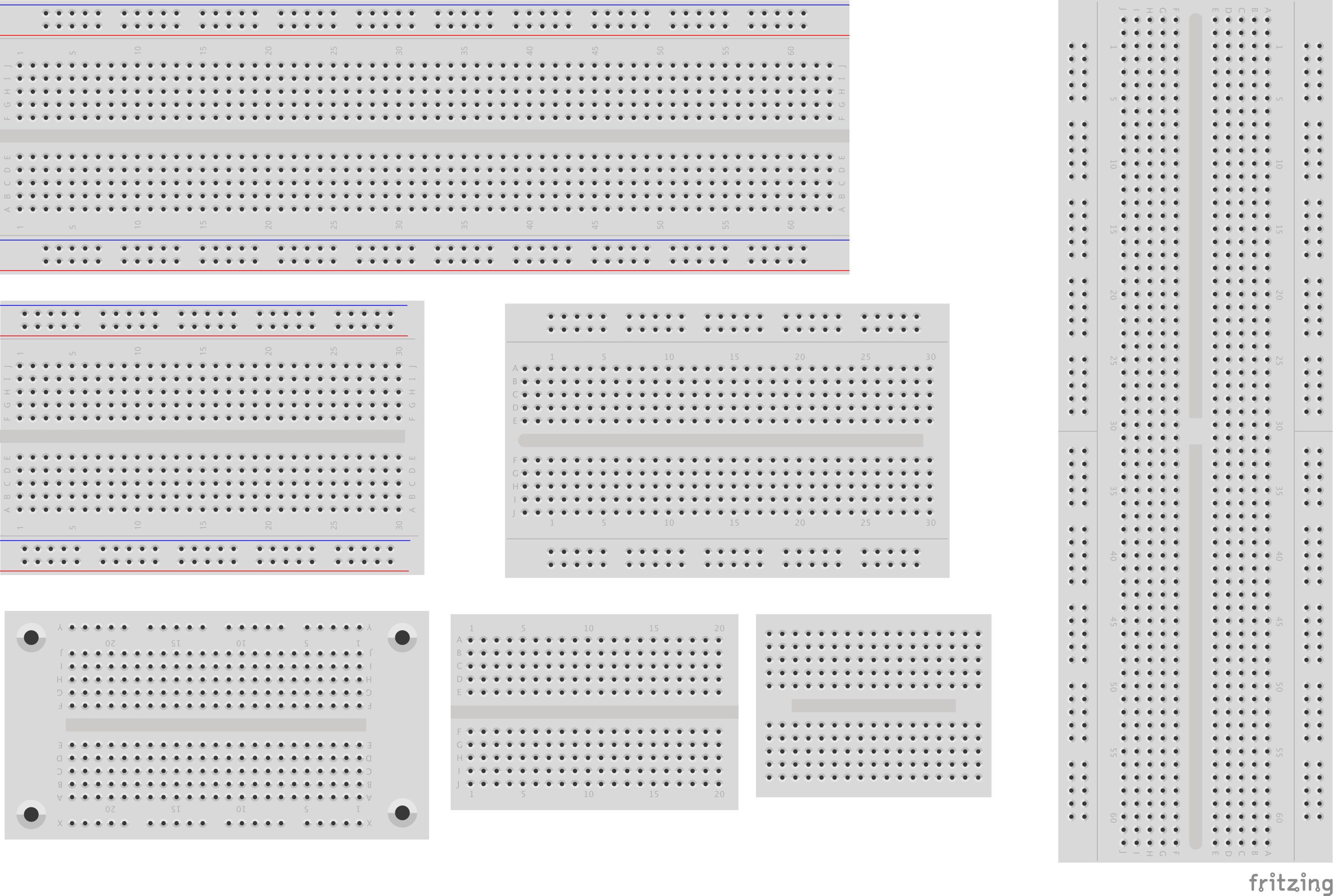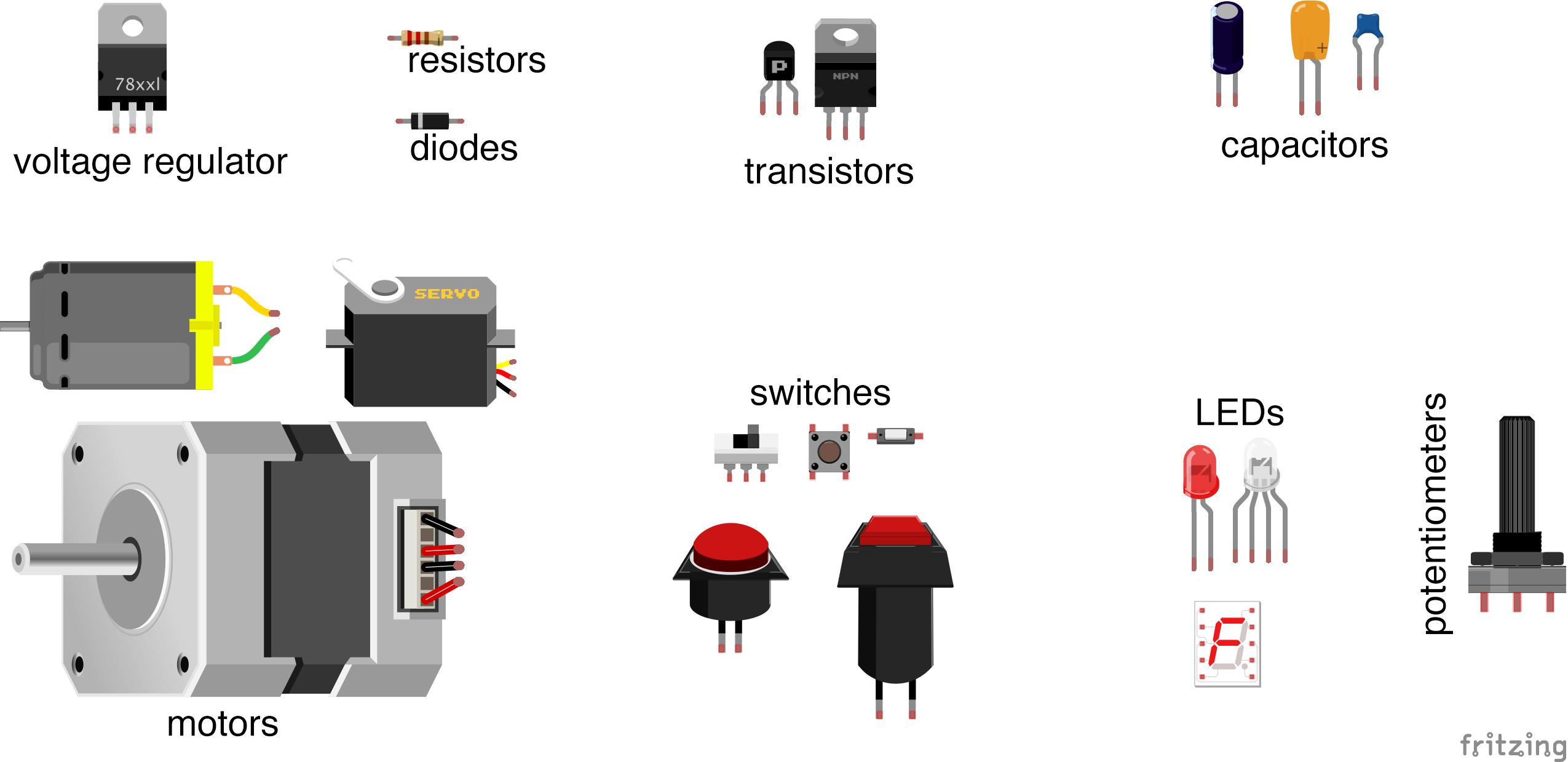Blinking Beeping Moving Sensing
Class page for IDM NYU DM-UY 4913 J Fall 2024
Syllabus Weekly Schedule Assignments & Projects Resources Cheat Sheet
Electronic Cheat Sheet
Electricity Basics
- Electricity is the flow of negatively charged electrons through a given material (usually copper wire or another conductor). We use this natural phenomenon to power a variety of devices and circuits.
- Electricity can be harnessed and converted, used to create light or motion, to transfer data and communicate between systems.
AC / DC
- AC – Alternating Current
- Current oscillates.
- fantastic for long distances/ high voltage / current applications
- Supplied from the electricity grid through wall outlets.
- In the US, AC is rated at 110/120 volts, and 60 Hertz
- In the UK, EU and other countries, it’s rated at 220/240 volts at 50Hz
- A list of all variations can be found here : https://www.school-for-champions.com/science/ac_world_volt_freq_list.htm
- Used to electrocute elephants
- DC – Direct Current
- Current flows in one direction.
- Typically the end of the line
- Most commonly found in day-to-day objects: battery powered tools, handheld and consumer electronics.
- Some devices — incandescent light bulbs, certain motors, heating elements — operate directly from AC current. Others (like many consumer electronics) accept AC current but translate it internally into DC current. Still others can only accept DC current.
Ohms Law
- V=IR — The foundational equation for how to calculate the different properties of a circuit: voltage, current, and resistance.
- Voltage is the difference in charge between two points.
- Current is the rate at which charge is flowing.
- Resistance is a material’s capacity to resist the flow of charge (current).
- Ohms Law is relevant when building a circuit, but also when troubleshooting a circuit. For example: identifying whether the voltage being supplied to a circuit is being used in its entirety and/or if any excess is being absorbed by the appropriate resistors.
What is a circuit?
- Circuits are closed loops that allow electricity to flow from a point of higher potential energy, such as a the positive lead on a battery, to a lower potential, through a load like a lightbulb.
- They control the movement of electricity in service of a specific purpose or outcome through assemblies of electrical components.
- The key components of safe and effective circuitry include:
- Understanding how to make sure that power flows correctly (and in its entirety) from an electrical source/power supply to a chosen output like a lightbulb or sound device.
- The necessity that circuits be complete (closed) in order to function.
- Understanding what causes short circuits and how to avoid them.
- Three things to remember about circuits
- All voltage is used in a circuit
- Electricity will follow the path of least resistance
- The amount of current flowing into a spot in a circuit is the same that flows out
Power vs Signal
- Electricity can be used to power a device or to create a signal. Examples of a power: to run a motor, turn on a lightbulb, etc.)
- a signal is a method of communication between devices, for example between 2 integrated circuits
- Circuits created for these different purposes share many things in common, but also have unique requirements. When creating a signal, elements like frequency and noise become important. Different materials may be used to construct (and different tools may be used to test) a power circuit as opposed to a signal circuit.
Power Supplies
- The source of electricity for your device/installation
- Could be batteries, wall worts, solar, wind, electro-magnetic in origin
- power for work could be either AC or DC
- Power supplies come in great variety and it is essential to identify the appropriate supply for a specific device.
- Key Components of a power supply:
- Voltage and Current
- AC/DC
- Polarity
Polarity
- Polarity indicates whether a circuit component is symmetric or not. A non-polarized (symmetric) component can be connected in any direction and still function the way it’s supposed to function. A polarized component can only be connected to a circuit in one direction. If connected in the wrong orientation, at best it won’t work as intended. At worst, it will smoke/spark/die.
- A common AA battery is a simple example of a polarized component: with positive and negative terminals that must be correctly aligned for it to function. Polarized elements in a circuit can be much more complicated though, with multiple connection points that each have a unique function and position.
Tools of the Trade
- How to Use a Multimeter
- A multimeter is multifunctional tool that can measure voltage, amperage, resistance, and continuity across a given component.
- How to use an oscilloscope
- An oscilloscope allows use to visualize the waveform of a given signal over time. We can use it to detect amplitude, frequency, and any potential inconsistencies.
- Breadboarding
- Breadboards offer the opportunity to prototype a circuit before constructing it in a more permanent form.

- Breadboards offer the opportunity to prototype a circuit before constructing it in a more permanent form.
-
Components

- power supplies
- These will provide power for the work. Typically plugged into a wall
- regulators
- a type of component that drops voltage across its pins. the excess is released as heat. A 7805 regulator, will drop the voltage in a circuit to 5V
- resistors
- resist the flow of electrical energy. Used to limit current and drop voltage.
- measured in ohms, you can determine the amount of resistance with a multimeter, or using a resistor color calculator
- never polarized
- capacitors
- components that store and discharge electricity over time. They are often used to smooth out irregularities in current and voltage.
- measured in farads, the amount of [capacitance can vary])(http://www.muzique.com/schem/caps.htm) and come in a wide variety of shapes and sizes
- some are polarized, others are not
- motors
- steppers
- brushless DC motor
- solenoids
- linear actuators that operate along the same principles as motors.
- relays
- a relay uses an electromagnet to open or close a switch. They make really fun clicking noises and are often used to control high voltage/high current circuits from a smaller, safer one
- transistors
- solid state switches used to amplify signals and power
- diodes
- polarized components that make sure electricity only flows in one direction. useful in AC circuits, or in DC circuits when using an inductive load like a motor
- LEDs
- the most fun diodes. they are polarized components that emit light when voltage is applied
- switches
- used to control the flow of electricity in a circuit. There are many shapes, sizes and kinds. The small pushbutton ones we have are momentary, but there are also latched ones that work like a lightswitch in that they hold their position.
- Series vs. Parallel circuits
- If components in a circuit are in series, there is only one path for current to flow through them.
- In parallel circuitry, current can take multiple paths between elements/components.
- Schematics
- A Schematic is a map of how to properly connect a given circuit. Symbols represent various components (like resistors, capacitors, switches, ics, and power sources) and lines represent connections between those components.